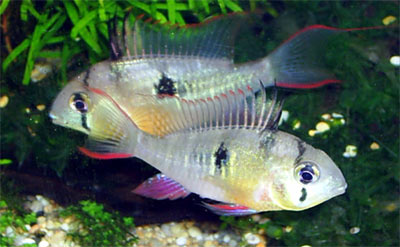Breeding
Bolivian Rams

Picture - Mark Breeze
Common Name: Bolivian Ram or Butterfly Cichlid
Scientific Name: Microgeophagus Altispinosa. (Haseman, 1911)
Family: Cichlidae.
Explanation of the scientific name: Refers to the elongated first ray of he dorsal fin. Altus (L.) = high, spinosus = spiny
Distribution: Rio Mamore above and below the junction with the Rio Guapore and around other place`s near the town of Trinidad, river basin of the Rio Guapore at Santa Cruz (Bolivia), Rio Quizer near San Ramon, depression below Todos Santos (Boliva) and the mouth of the Igarape near Guajara-Mirim (Brazil)
Size: Males up to 9 ½ cm and females 8cm
Diet: These fish are omnivores and will accept most dry and live foods. Try to give them a variety of different foods live brine shrimp, pellets, Spirulina, flakes etc.
Water Temperature: 25-28 degrees Centigrade (77-82 degrees Fahreheit).
Water Chemistry:A gh & kh of less than 10 is best.
pH: pH 6.8-7.0 is best, although they can live happily in water with a pH 7.8.
Life Span: Approx 2-4 years.
Tank requirements: The tank should have a length of at least 80cm with lots of plants and other hiding places and an open front area to allow them space to swim. Sexing:
There is little sexual dimorphism when young. Males are slimmer and not as stocky than females and also have extensions on the upper and inner rays of the dorsal and caudal fins. Another difference is the dorsal on the males is more pointed and elongated.
Breeding: These fish are open substrate spawners and will spawn on a rock or similar object, I use red rocks as preferred by Microgeophagus Ramirezi. Once they have paired up, which they often do for life, they will select a spawning site and clear it of sand and debris. When they are doing this and during spawning the can get a little aggressive, but is more for show than anything and they don't seem to actually do any damage to the other fish. At the start of spawning, the female will lay a few eggs on the stone and will then move away a little to allow the male to come over them and fertilise them. They will do this until there are around 100-200 eggs. After spawning, the female will fan the eggs whilst the male guards the eggs from any predators. Once they are free swimming, the fry will be moved off the rock into a depression made by the parents and looked after there. If the fry wander too far from the depression, the parents will collect them up in their mouth and take them back. It is known for them to be poor parents though and the best chance of fry survival is to remove them and put them in a separate tank.
Description: These colourful, little fish are peaceful and can be kept in a community tank. They can show very nice coloration, blue, yellow, gold, orange, bronze and black on them when settled. Both male and female have a dot in the middle of the body
Author - Paul Fox
|







